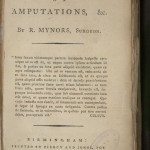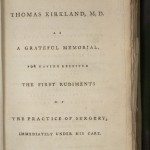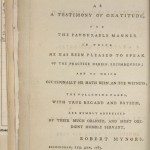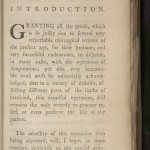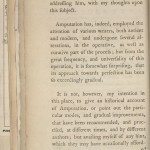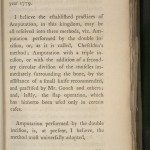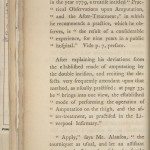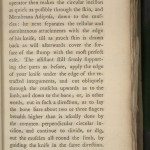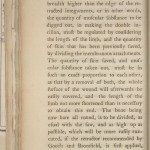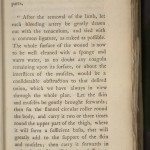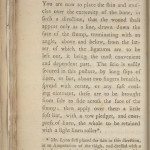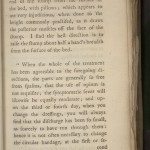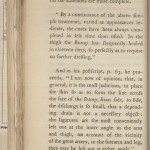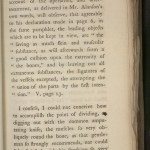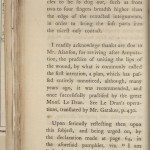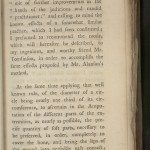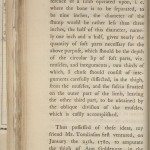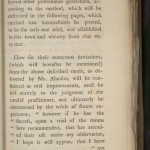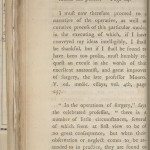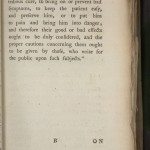Practical Thoughts on Amputations: 1. Frontispiece and Introduction
Robert Mynors, a pioneer of surgical treatment in 18th century Birmingham
Robert Mynors was one of the lesser-known medical figures of the West Midlands in the late 18th century. His reputation has been eclipsed by John Ash, who founded Birmingham’s General Hospital, Erasmus Darwin, probably England’s best doctor at the time, William Small one of the creators of the Lunar Society and William Withering, discoverer of the scientific properties of the heart drug, digitalis.
Mynors, nevertheless was an important figure, contributing to a widening understanding of surgical techniques and medical care. Little is known about his life. In Swinney’s Birmingham Directory of 1774, he is described as a “Surgeon and Man-midwife”, living at “14 Square”. Surgeons were apprenticed to their trade and had a lower status than university trained doctors, but they were gradually acquiring an improving reputation as their knowledge of anatomy and medical science increased. Mynors contributed to this trend. He wrote Practical Thoughts on Amputations in 1783, which dealt with techniques of surgical amputation and the post-operative care of amputees. The multi-tailed bandage is credited as his invention. The book was dedicated to two doctors, Thomas Kirkland, from whom he learned the basics of surgery and William Withering. His second publication in 1785, A History of the Practice of Trepanning the Skull and the after-treatment; with observations upon a new method of care, explores the techniques and treatment involved in this form of surgery. Trepanning was one of the few operations performed on patients before the advent of anaesthetics in the 19th century. It involved removing a portion of the skull to relieve a number of head injuries.
In about 1780 Robert Mynors moved to Snow Hill and by 1783 he had rented part of his house to James Millar, a local artist. Millar produced portraits of several Birmingham figures including John Baskerville, the printer, Francis Eginton, the engraver and John Freeth, the poet. He also painted Robert Mynors and his family. The Mynors family originally came from Uttoxeter in Staffordshire, and then moved to Weatheroak Hall in Alvechurch, Worcestershire. The portrait, which dates from the 1790s, shows the Mynors in, it seems, Weatheroak Hall and appears to have several allegorical features, including a blazing fire in the background, which may be alluding to the Priestley Riots of 1791. It is located in the Dining Room of Soho House Museum, Handsworth, Birmingham, and is the only known portrait of Robert Mynors.
The extracts from his two books illustrate his contributions to surgery and the care of patients.
————————————
Practical Thoughts on AMPUTATIONS, &c.
By R. Mynors, SURGEON
BIRMINGHAM:
Printed by Piercy and Jones, for G. Robinson, Pater-Noster-Row, London.
[1783]
To
THOMAS KIRKLAND, M.D.
AS
A GRATEFUL MEMORIAL,
FOR HAVING RECEIVED
THE FIRST RUDIMENTS
OF
THE PRACTICE OF SURGERY,
IMMEDIATELY UNDER HIS CARE
TO
WILLIAM WITHERING, M.D.
AS
A TESTIMONY OF GRATITUDE
FOR
THE FAVOURABLE MANNER
IN WHICH
HE HAS BEEN PLEASED TO SPEAK
OF THE PRACTICE HEREIN RECOMMENDED;
AND TO WHICH
OCCASIONALLY HE HATH BEEN AN EYE WITNESS
THE FOLLOWING PAGES,
WITH TRUE REGARD AND ESTEEM,
ARE HUMBLY ADDRESSED
BY THEIR MUCH OBLIGED, AND MOST OBEDIENT HUMBLE SERVANT,
ROBERT MYNORS
BIRMINGHAM, FEB. 4TH, 1783.
INTRODUCTION
Granting all the praise, which is so justly due to several very respectable chirurgical writers of the present age, for their humane, and very successful endeavours, to dispense, in many cases, with the operation of Amputation; yet this very lamentable truth must be universally acknowledged, that in a variety of diseases, afflicting different parts of the limbs of mankind, this dreadful operation, still remains the only remedy to procure relief, or even preserve the life of the patient.
The necessity of this operation then being admitted, will, I hope, in some measure, apologise to the candid practitioner,
[2]
Introduction
for the liberty I take in humbly addressing him, with my thoughts upon this subject.
Amputation has, indeed, employed the attention of various writers, both antient and modern, and undergone several alterations in the operative, as well as curative part of the process; but from the great frequency, and universality of this operation, it is somewhat surprising, that its approach towards perfection has been so exceedingly gradual.
It is not, however, my intention in this place, to give an historical account of Amputation, or point out the particular modes, and gradual improvements, that have been recommended, and practised, at different times, and by different authors; but availing myself of any hint which they may have occasionally afforded
[3]
Introduction
me, shall begin the subject at the year 1779.
I believe the established practices of Amputation, in this kingdom, may be all resolved into three methods, viz. Amputation performed by the double incision, or, as it is called, Cheselden’s method: Amputation with a triple incision, or with the addition of a secondary circular division of the muscles immediately surrounding the bone, by the assistance of a small knife recommended, and practised by Mr. Gooch and others; and lastly, the flap operation, which has hitherto been used only in certain cases.
Amputation performed by the double incision, is, at present, I believe, the method most universally adopted,
[4]
Introduction
Mr. Alanson, of Liverpool, published in the year 1779, a treatise intitled “Practical Observations upon Amputation, and the After-Treatment;” in which he recommends a practice, which he observes, is “the result of a considerable experience, for nine years in a public hospital” Vide p.7, preface.
After explaining his deviations from the established mode of amputating by the double incision, and reciting the defects very frequently attendant upon that method, as usually practised; at page 33, he “brings into one view, the established mode of performing the operation of Amputation on the thigh, and the after-treatment, as practised in the Liverpool Infirmary.”
“Apply,” says Mr. Alanson, “the tourniquet as usual, and let an assistant draw up the skin and muscles, by firmly
[5]
Introduction
grasping the limb with both hands, the operator then make the circular incision as quick as possible through the skin, and Membrana Adiposa, down to the muscles: he next separates the cellular and membranous attachments with the edge of his knife, till as much skin is drawn back as will afterwards cover the surface of the stump with the most perfect ease. The assistant still firmly supporting the parts as before, apply the edge of your knife under the edge of the retracted integuments, and cut obliquely through the muscles upwards as to the limb and down to the bone; or, in other words, cut in such a direction, as to lay the bone bare about two or three fingers breadth higher than is usually done by the common perpendicular circular incision, and continue to divide, or dig, out the muscles all round the limb, by guiding the knife in the same direction. The part where the bone is to be laid
[6]
Introduction
bare, whether two, three, or four fingers breadth higher than the edge of the retracted integuments, or in other words, the quantity of muscular substance to be digged out, in making the double incision, must be regulated by considering the length of the limb, and the quantity of skin that has been previously saved, by dividing the membranous attachments. The quantity of skin saved, and muscular substance taken out, must be in such an exact proportion to each other, as that by a removal of both, the whole surface of the wound will afterwards be easily covered, and the length of the limb not more shortened than is necessary to obtain this end. The bone being now bare all round, is to be divided, as usual with the saw, and as high up as possible, which will be more easily executed if the retractor recommended by Gooch and Bromfield, is first applied,
[7]
Introduction
for the support and defence of the soft parts.
“After the removal of the limb, let each bleeding artery be gently drawn out with the tenaculum, and tied with a common ligature, as naked as possible. The whole surface of the wound is now to be well cleaned with a sponge and warm water, as no doubt any coagula remaining upon its surface, or about the interstices of the muscles, would be a considerable obstruction to the desired union, which we have always in view through the whole plan. Let the skin and muscles be gently brought forwards; then fix the flannel circular roller round the body, and carry it two or three times round the upper part of the thigh, where it will form as sufficient basis, that will greatly add to the support of the skin and muscles; then carry it forwards in a circular direction till it arrives sufficiently
[8]
Introduction
near the extremity of the stump, where it is to be fastened as usual. You are now to place the skin and muscles over the extremity of the bone, in such a direction, that the wound shall appear only as a line, drawn down the face of the stump, terminating with an angle, above and below, from the latter of which the ligatures are to be left out, it being the most convenient and dependent part. The skin is easy secured in this posture, by long slips of linen, or lint, about two fingers breadth, spread with cerate, or any soft cooling ointment, these are to be brought from side to side across the face of the stump; then apply over them a little soft lint, with a tow pledget, and compress of linen, the whole to be retained with a light linen roller*
*Mr. Lyon first placed the skin in this direction, in an Amputation of the thigh, and dressed with a dry linen cross cloth, applied from side to side, next the face of the stump.
[9]
Introduction
“It is the usual custom, to raise the end of the stump from the surface of the bed, with pillows; which appears to me very injudicious, when done to the height commonly practised, as it draws the posterior muscles off the face of the stump. I find the best direction is to raise the stump about half a hand’s breadth from the surface of the bed.
“When the whole of the treatment has been agreeable to the foregoing directions, the parts are generally so free from spasms, that the use of opium is not requisite; the symptomatic fever will likewise be equally moderate; and upon the third or fourth day, when you change the dressings, you will always find that the discharge has been so small, as scarcely to have run through them, hence it is not necessary to change the circular bandage, at the first or second
[10]
Introduction
dressing; I rather wish to avoid it, till the adhesions are more complete.
“By a continuance of the above simple treatment, varied as appearances indicate, the cures have been always completed in less time than usual. In the thigh the stump has frequently healed in nineteen days, so perfectly as to require no further dressing.”
And in his postscript, p.63, he proceeds, “I am now of opinion, that, in general, it is the most judicious, to place the skin so as to form the line across the face of the stump, from side, to side, the discharge is so small, that a depending drain is not a necessary object: the ligatures are the most conveniently left out at the inner angle in the arm and thigh, on account of the vicinity of the great artery, in the forearm and the leg, they may be left out at either angle.”
[11]
Introduction
Whoever attentively considers this account of the operation, and after-treatment, as delivered in Mr. Alanson’s own words, will observe, that agreeably to his declaration made in page 6, in the same pamphlet, the leading objects which are kept in view, are “the saving as much skin and muscular substance, as will afterwards for a good cushion upon the extremity of the bones”, and by leaving out all extraneous substances, the ligatures of the vessels excepted, the attempting the “union of the parts by the first intention.” V. page 13.
I confess I could not conceive how to accomplish the point of dividing, [or] digging out with the common amputating knife, the muscles so very obliquely round the bone, as that gentleman so strongly recommends, not could I be satisfied with his speaking so very,
[12]
Introduction
vaguely, respecting the quantity of muscles to be so dug out, such as from two to four fingers breadth higher than the edge of the retracted integuments, in order to bring the soft parts into the nicest easy contact.
I readily acknowledge thanks are due to Mr. Alanson, for reviving after Amputation, the practice of uniting the lips of the wound, by what is commonly called the first intention, a plan, which has passed entirely unnoticed, although, many years ago, it was recommended, and once successfully practised by the great Mons. Le Dran. See Le Dran’s operations, translated by Mr. Gataker, p.430.
Upon seriously reflecting then upon this subject, and being urged on, by the declaration made at page 64, in the aforesaid pamphlet, viz. “I am far from thinking that the operation
[13]
Introduction
and after-treatment, will not yet admit of further improvements in the hands of the judicious and candid practitioner:” and calling to mind the known effects of a somewhat similar practice, which I had seen confirmed; I presumed to recommend the mode, which will hereafter be described , to my ingenious, and worthy friend Mr. Tomlinson, in order to accomplish the same effects proposed by Mr. Alanson’s method.
At the same time applying that well known rule, of the diameter of a circle being nearly one third of its circumference, to ascertain in the Amputation of the different parts of the extremities, as nearly as possible, the precise quantity of soft parts, necessary to be preserved, in order, completely to cover the bone, and bring the lips of the wound into perfectly easy contact;
[14]
Introduction
for example, if we suppose the circumference of a limb operated upon, i.e. where the bone is to be separated, to be nine inches, the diameter of the stump would be rather less than three inches, the half of this diameter, namely one inch and a half, gives nearly the quantity of soft parts necessary for the above purpose, which should be the depth of the circular lip of soft parts, viz. muscles, and integuments; two thirds of which, I chuse should consist of integuments carefully dissected, in the thigh, from the muscles, and the fascia situated on the outer part of the limb, leaving the other third part, to be obtained by the oblique division of the muscles, which is easily accomplished.
Thus possessed of these ideas, my friend Mr. Tomlinson first ventured, on January the 25th, 1780, to amputate the thigh of Ann Goldengay, in the
[15]
Introduction
presence of Mr. Kennedy, Mr. Vaux and several other professional gentlemen, according to the method, which will be described in the following pages, which method can incontestably be proved, to be the only one used, and established in this town and vicinity from that very date.
How far these numerous deviations (which will hereafter be mentioned) from the above described mode, as delivered by Mr. Alanson, will be considered as real improvements, must be left entirely to the judgement of the candid practitioner, and ultimately be determined by the result of future experience; “however if he has the success, upon a trial of the means here recommended, that has attended their use under my observation, I hope it will appear, that I have
[16]
Introduction
not either misapplied my time, or misled the public.” Page 64.
I must now therefore proceed to a narrative of the operative, as well as curative process of this particular mode; in the executing of which, if I have conveyed my ideas intelligibly, I shall be thankful, but if I shall be found to have been too prolix, must humbly request an excuse in the words of that excellent anatomist, and great improver of surgery, the late professor Monro. V. ed. medic. essays; vol. 4th, page 257.
“In the operations of surgery,” says the celebrated professor, “there is a number of little circumstances, several of which seem at first view to be of no great consequence; but when their observation or neglect comes to be attended to in practice, they are found to
[17]
Introduction
contribute considerably to a speedy or tedious cure, to bring on or prevent bad symptoms, to keep the patient easy, and preserve him, or to put him to pain and bring him into danger; and therefore their good or bad effects ought to be duly considered, and the proper cautions concerning them ought to be given by those, who write for the public upon such subjects.”
Sources and Further ReadingI am grateful to Doreen Hopwood, Birmingham Libraries and Jane McArdle, Birmingham Museums and Art Gallery for supplying information about Robert Mynors.
Bailey, W, Bailey’s Western and Midland Directory of Merchants’ and Tradesmen’s useful Companion for the Year 1783. (Birmingham, Rollaston and Pearson, 1783)
Hill, Joseph and Dent, Robert, Memorials of the Old Square. (Birmingham, Achilles Taylor, 1897). This contains the only account of Mynors’ importance.
Mynors, Robert, Practical Thoughts on Amputations &c., (Birmingham, Piercy and Jones, 1783).
Mynors, Robert, A History of the Practice of Trepanning the Skull and the after-treatment; with observations upon a new method of care (Birmingham, Piercy and Jones for G Robinson, 1785).
Swinney, Myles, The New Birmingham Directory and Gentleman’s and Tradesman’s Compleat Memorandum Book. (Birmingham, M Swinney, 1774).



